Knowledge Map of Climate Change and Transportation: A Bibliometric Analysis Based on CiteSpace
Abstract
1. Introduction
2. Materials and Methods
3. Results
3.1. Collaboration Analysis
3.1.1. Country/Region Collaboration Network
3.1.2. Institution Collaboration Network
3.1.3. Author Collaboration Network
3.2. Co-Citation Analysis
3.2.1. Author Co-Citation Analysis
3.2.2. Reference Co-Citation Analysis
- (1)
- Policy option
- (2)
- Travel behaviour
- (3)
- COVID-19 lockdown
- (4)
- Environmental cost
- (5)
- Air quality
3.3. Co-Word Analysis
4. Future Research Prospects
- (1)
- A greater focus on new opportunities brought about by new technologies and practices. New technologies related to transport can provide opportunities to address environmental issues. New-energy vehicles come with high expectations to solve the current environmental and energy dilemmas [66] and are likely to eventually form the backbone of the industry, replacing internal combustion engine vehicles [67]. Existing research will no longer provide sufficient decision support when electric vehicles gradually take up a greater market share. At the same time, autonomous vehicles and travel apps have the potential to profoundly change people’s travel behaviour and the transportation sector itself [68,69]. How the use of these new technologies in the transportation sector will affect climate change will be a focus of future research.
- (2)
- A greater focus on the long-term impacts of climate change on the transport sector. Due to the high level of uncertainty about future climate change, current research mostly focuses on the short-term impacts of climate change on the transport sector [3]. Most transport initiatives are organisational or planning in nature, involving top-down policy models [70]. Therefore, the long-term effects of policies are naturally one of the goals pursued by policymakers. As cities expand, environmental concerns and congestion become more serious, and many governments choose to expand their transport networks. Both land use and investment require stable decision models that allow transport infrastructure to adapt to new climate parameters.
- (3)
- A greater focus on developing countries. As shown in Section 3, most of the research in this field was contributed by scholars from developed countries. However, many developing countries, particularly rapidly growing countries, are experiencing more challenging environmental problems, limited access to clean technologies and well-enforced ecological regulations [71]. In future research, the effects of existing transport policies in developing countries can be assessed while focusing on the impact of new technologies in transport and energy.
- (4)
- A greater focus on the machine learning algorithms that can be applied in this research field. As shown in the co-word analysis section, the keyword “machine learning”, with the strongest citation burst, has received much attention in the past two years. Research on the development of sustainable transport systems has been increasing in the past 10 years, but mainly simulation and optimisation models, with few machine learning methods. Many problems arising from the impact of the transport sector on climate change can be solved by using machine learning methods, such as reducing transport activity, improvising vehicle efficiency, battery energy management, and low carbon intensity modal shift [72]. On the other hand, air quality [73] and carbon emissions [74] can also be predicted by machine learning. The application of machine learning in other research fields has been very extensive, and its application in this field will inevitably become a future trend.
5. Conclusions
5.1. Contributions
5.2. Limitations
Author Contributions
Funding
Institutional Review Board Statement
Informed Consent Statement
Data Availability Statement
Acknowledgments
Conflicts of Interest
References
- Weber, E.U.; Stern, P.C. Public Understanding of Climate Change in the United States. Am. Psychol. 2011, 66, 315. [Google Scholar] [CrossRef]
- Bandh, S.A.; Shafi, S.; Peerzada, M.; Rehman, T.; Bashir, S.; Wani, S.A.; Dar, R. Multidimensional Analysis of Global Climate Change: A Review. Environ. Sci. Pollut. Res. 2021, 28, 24872–24888. [Google Scholar] [CrossRef]
- Wang, T.; Qu, Z.; Yang, Z.; Nichol, T.; Clarke, G.; Ge, Y.-E. Climate Change Research on Transportation Systems: Climate Risks, Adaptation and Planning. Transp. Res. Part D Transp. Environ. 2020, 88, 102553. [Google Scholar] [CrossRef]
- Fiske, S.; Hubacek, K.; Jorgenson, A.; Li, J.; McGovern, T.; Rick, T.; Schor, J.; Solecki, W.; York, R.; Zycherman, A. Drivers and Responses: Social Science Perspectives on Climate Change, Part 2. In Proceedings of the Washington, DC: USGCRP Social Science Coordinating Committee. 2018. Available online: https://www.globalchange.gov/content/social-science-perspectives-climate-change-workshop (accessed on 23 September 2022).
- Love, G.; Soares, A.; Püempel, H. Climate Change, Climate Variability and Transportation. Procedia Environ. Sci. 2010, 1, 130–145. [Google Scholar] [CrossRef]
- Aroke, O.M.; Esmaeili, B.; Kim, S.C. Impact of Climate Change on Transportation Infrastructure: Comparing Perception Differences between the US Public and the Department of Transportation (DOT) Professionals. Sustainability 2021, 13, 11927. [Google Scholar] [CrossRef]
- Hendricks, J.; Righi, M.; Dahlmann, K.; Gottschaldt, K.-D.; Grewe, V.; Ponater, M.; Sausen, R.; Heinrichs, D.; Winkler, C.; Wolfermann, A. Quantifying the Climate Impact of Emissions from Land-Based Transport in Germany. Transp. Res. Part D Transp. Environ. 2018, 65, 825–845. [Google Scholar] [CrossRef]
- Ng, A.K.Y.; Becker, A.; Cahoon, S.; Chen, S.-L.; Earl, P.; Yang, Z. Time to Act: The Criticality of Ports in Adapting to the Impacts Posed by Climate Change. In Climate Change and Adaptation Planning for Ports; Routledge: London, UK, 2015; pp. 33–40. ISBN 1315756811. [Google Scholar]
- Van Fan, Y.; Perry, S.; Klemeš, J.J.; Lee, C.T. A Review on Air Emissions Assessment: Transportation. J. Clean. Prod. 2018, 194, 673–684. [Google Scholar] [CrossRef]
- Feng, Q.; Gauthier, P. Untangling Urban Sprawl and Climate Change: A Review of the Literature on Physical Planning and Transportation Drivers. Atmosphere 2021, 12, 547. [Google Scholar] [CrossRef]
- Kraus, L.; Proff, H. Sustainable Urban Transportation Criteria and Measurement—A Systematic Literature Review. Sustainability 2021, 13, 7113. [Google Scholar] [CrossRef]
- Kwan, S.C.; Hashim, J.H. A Review on Co-Benefits of Mass Public Transportation in Climate Change Mitigation. Sustain. Cities Soc. 2016, 22, 11–18. [Google Scholar] [CrossRef]
- Rebally, A.; Valeo, C.; He, J.; Saidi, S. Flood Impact Assessments on Transportation Networks: A Review of Methods and Associated Temporal and Spatial Scales. Front. Sustain. Cities 2021, 3, 732181. [Google Scholar] [CrossRef]
- Lee, P.T.-W.; Chung, Y.-S.; Lam, J.S.L. Transportation Research Trends in Environmental Issues: A Literature Review of Methodology and Key Subjects. Int. J. Shipp. Transp. Logist. 2016, 8, 612–631. [Google Scholar] [CrossRef]
- Nalimov, V.V.; Mulʹchenko, Z.M. Measurement of Science. Study of the Development of Science as an Information Process; U.S. Air Force Systems Command, Foreign Technology Division: Virginia, CA, USA, 1971. [Google Scholar]
- Chen, C.; Hu, Z.; Liu, S.; Tseng, H. Emerging Trends in Regenerative Medicine: A Scientometric Analysis in CiteSpace. Expert Opin. Biol. Ther. 2012, 12, 593–608. [Google Scholar] [CrossRef]
- van Eck, N.J.; Waltman, L. Software Survey: VOSviewer, a Computer Program for Bibliometric Mapping. Scientometrics 2010, 84, 523–538. [Google Scholar] [CrossRef] [PubMed]
- Garfield, E. From the Science of Science to Scientometrics Visualizing the History of Science with HistCite Software. J. Informetr. 2009, 3, 173–179. [Google Scholar] [CrossRef]
- Chen, C. CiteSpace II: Detecting and Visualizing Emerging Trends and Transient Patterns in Scientific Literature. J. Am. Soc. Inf. Sci. Technol. 2006, 57, 359–377. [Google Scholar] [CrossRef]
- Mingers, J.; Leydesdorff, L. A Review of Theory and Practice in Scientometrics. Eur. J. Oper. Res. 2015, 246, 1–19. [Google Scholar] [CrossRef]
- Bankar, R.S.; Lihitkar, S.R. Science Mapping and Visualization Tools Used for Bibliometric and Scientometric Studies: A Comparative Study. J. Adv. Libr. Sci. 2019, 6, 382–394. [Google Scholar]
- Searchinger, T.; Heimlich, R.; Houghton, R.; Dong, F.; Elobeid, A.; Fabiosa, J.F.; Tokgoz, S.; Hayes, D.J.; Yu, T. Factoring Greenhouse Gas Emissions from Land Use Change into Biofuel Calculations. Science 2008, 29, 1238–1240. [Google Scholar] [CrossRef] [PubMed]
- Fargione, J.; Hill, J.; Tilman, D.; Polasky, S.; Hawthorne, P. Land clearing and the biofuel carbon debt. Science 2008, 319, 1235–1238. [Google Scholar] [CrossRef]
- Farrell, A.E.; Plevin, R.J.; Turner, B.T.; Jones, A.D.; O’hare, M.; Kammen, D.M. Ethanol Can Contribute to Energy and Environmental Goals. Science 2006, 311, 506–508. [Google Scholar] [CrossRef] [PubMed]
- Change, I.C. Mitigation of Climate Change. Contrib. Work Group III Fifth Assess. Rep. Intergov. Panel Clim. Chang. 2014, 1454, 147. [Google Scholar]
- Le Quéré, C.; Jackson, R.B.; Jones, M.W.; Smith, A.J.P.; Abernethy, S.; Andrew, R.M.; De-Gol, A.J.; Willis, D.R.; Shan, Y.; Canadell, J.G. Temporary Reduction in Daily Global CO 2 Emissions during the COVID-19 Forced Confinement. Nat. Clim. Chang. 2020, 10, 647–653. [Google Scholar] [CrossRef]
- Rogelj, J.; Den Elzen, M.; Höhne, N.; Fransen, T.; Fekete, H.; Winkler, H.; Schaeffer, R.; Sha, F.; Riahi, K.; Meinshausen, M. Paris Agreement Climate Proposals Need a Boost to Keep Warming Well below 2 C. Nature 2016, 534, 631–639. [Google Scholar] [CrossRef] [PubMed]
- Ewing, R.; Cervero, R. Travel and the Built Environment: A Meta-Analysis. J. Am. Plan. Assoc. 2010, 76, 265–294. [Google Scholar] [CrossRef]
- Masson-Delmotte, V.; Zhai, P.; Pörtner, H.-O.; Roberts, D.; Skea, J.; Shukla, P.R.; Pirani, A.; Moufouma-Okia, W.; Péan, C.; Pidcock, R. Global Warming of 1.5 C. IPCC Spec. Rep. Impacts Glob. Warm. 2018, 1, 43–50. [Google Scholar]
- Chen, C.; Dubin, R.; Kim, M.C. Emerging Trends and New Developments in Regenerative Medicine: A Scientometric Update (2000–2014). Expert Opin. Biol. Ther. 2014, 14, 1295–1317. [Google Scholar] [CrossRef]
- Lade, G.E.; Lawell, C.-Y.C.L. The Design and Economics of Low Carbon Fuel Standards. Res. Transp. Econ. 2015, 52, 91–99. [Google Scholar] [CrossRef]
- Creutzig, F.; Fernandez, B.; Haberl, H.; Khosla, R.; Mulugetta, Y.; Seto, K.C. Beyond Technology: Demand-Side Solutions for Climate Change Mitigation. Annu. Rev. Environ. Resour. 2016, 41, 173–198. [Google Scholar] [CrossRef]
- Creutzig, F. Evolving Narratives of Low-Carbon Futures in Transportation. Transp. Rev. 2016, 36, 341–360. [Google Scholar] [CrossRef]
- Edelenbosch, O.Y.; McCollum, D.L.; Van Vuuren, D.P.; Bertram, C.; Carrara, S.; Daly, H.; Fujimori, S.; Kitous, A.; Kyle, P.; Broin, E.Ó. Decomposing Passenger Transport Futures: Comparing Results of Global Integrated Assessment Models. Transp. Res. Part D Transp. Environ. 2017, 55, 281–293. [Google Scholar] [CrossRef]
- Yeh, S.; Mishra, G.S.; Fulton, L.; Kyle, P.; McCollum, D.L.; Miller, J.; Cazzola, P.; Teter, J. Detailed Assessment of Global Transport-Energy Models’ Structures and Projections. Transp. Res. Part D Transp. Environ. 2017, 55, 294–309. [Google Scholar] [CrossRef]
- Axsen, J.; Wolinetz, M. Reaching 30% Plug-in Vehicle Sales by 2030: Modeling Incentive and Sales Mandate Strategies in Canada. Transp. Res. Part D Transp. Environ. 2018, 65, 596–617. [Google Scholar] [CrossRef]
- Böcker, L.; Dijst, M.; Prillwitz, J. Impact of Everyday Weather on Individual Daily Travel Behaviours in Perspective: A Literature Review. Transp. Rev. 2013, 33, 71–91. [Google Scholar] [CrossRef]
- Taylor, M.A.P.; Philp, M. Adapting to Climate Change-Implications for Transport Infrastructure, Transport Systems and Travel Behaviour. Road Transp. Res. A J. Aust. N. Z. Res. Pract. 2010, 19, 66–79. [Google Scholar]
- Avineri, E. On the Use and Potential of Behavioural Economics from the Perspective of Transport and Climate Change. J. Transp. Geogr. 2012, 24, 512–521. [Google Scholar] [CrossRef]
- Cohen, S.A.; Higham, J.E.S.; Reis, A.C. Sociological Barriers to Developing Sustainable Discretionary Air Travel Behaviour. J. Sustain. Tour. 2013, 21, 982–998. [Google Scholar] [CrossRef]
- Howarth, C.; Waterson, B.; McDonald, M. Public Understanding of Climate Change and the Gaps between Knowledge, Attitudes and Travel Behaviour. In Proceedings of the 88th Transport Research Board Annual Meeting Washington, Washington, DC, USA, 11–15 January 2009. [Google Scholar]
- Fletcher, J.; Higham, J.; Longnecker, N. Climate Change Risk Perception in the USA and Alignment with Sustainable Travel Behaviours. PLoS ONE 2021, 16, e0244545. [Google Scholar] [CrossRef]
- Prillwitz, J.; Barr, S. Moving towards Sustainability? Mobility Styles, Attitudes and Individual Travel Behaviour. J. Transp. Geogr. 2011, 19, 1590–1600. [Google Scholar] [CrossRef]
- Marsden, G.; Mullen, C.; Bache, I.; Bartle, I.; Flinders, M. Carbon Reduction and Travel Behaviour: Discourses, Disputes and Contradictions in Governance. Transp. Policy 2014, 35, 71–78. [Google Scholar] [CrossRef]
- Lu, Q.-C.; Zhang, J.; Peng, Z.-R.; Rahman, A.B.M.S. Inter-City Travel Behaviour Adaptation to Extreme Weather Events. J. Transp. Geogr. 2014, 41, 148–153. [Google Scholar] [CrossRef]
- Gkatzelis, G.I.; Gilman, J.B.; Brown, S.S.; Eskes, H.; Gomes, A.R.; Lange, A.C.; McDonald, B.C.; Peischl, J.; Petzold, A.; Thompson, C.R. The Global Impacts of COVID-19 Lockdowns on Urban Air Pollutiona Critical Review and Recommendations. Elem. Sci. Anthr. 2021, 9, 176. [Google Scholar] [CrossRef]
- Camargo-Caicedo, Y.; Mantilla-Romo, L.C.; Bolaño-Ortiz, T.R. Emissions Reduction of Greenhouse Gases, Ozone Precursors, Aerosols and Acidifying Gases from Road Transportation during the COVID-19 Lockdown in Colombia. Appl. Sci. 2021, 11, 1458. [Google Scholar] [CrossRef]
- Soni, A.R.; Amrit, K.; Shinde, A.M. COVID-19 and Transportation of India: Influence on Infection Risk and Greenhouse Gas Emissions. Environ. Dev. Sustain. 2022, 25, 1–16. [Google Scholar] [CrossRef] [PubMed]
- Restrepo, C.E. Nitrogen Dioxide, Greenhouse Gas Emissions and Transportation in Urban Areas: Lessons from the COVID-19 Pandemic. Front. Environ. Sci. 2021, 204, 689985. [Google Scholar] [CrossRef]
- Wong, Y.J.; Shiu, H.-Y.; Chang, J.H.-H.; Ooi, M.C.G.; Li, H.-H.; Homma, R.; Shimizu, Y.; Chiueh, P.-T.; Maneechot, L.; Sulaiman, N.M.N. Spatiotemporal Impact of COVID-19 on Taiwan Air Quality in the Absence of a Lockdown: Influence of Urban Public Transportation Use and Meteorological Conditions. J. Clean. Prod. 2022, 365, 132893. [Google Scholar] [CrossRef]
- Kallbekken, S.; Sælen, H. Public Support for Air Travel Restrictions to Address COVID-19 or Climate Change. Transp. Res. Part D: Transp. Environ. 2021, 93, 102767. [Google Scholar] [CrossRef]
- Zhang, A.; Boardman, A.E.; Gillen, D.; Waters, I. Towards Estimating the Social and Environmental Costs of Transportation in Canada. Rep. Transp. Can. 2004, 7. [Google Scholar]
- Hill, J. Environmental Costs and Benefits of Transportation Biofuel Production from Food-and Lignocellulose-Based Energy Crops: A Review. Sustain. Agric. 2009, 125–139. [Google Scholar]
- Ko, S.; Lautala, P.; Fan, J.; Shonnard, D.R. Economic, Social, and Environmental Cost Optimization of Biomass Transportation: A Regional Model for Transportation Analysis in Plant Location Process. Biofuels Bioprod. Biorefin. 2019, 13, 582–598. [Google Scholar] [CrossRef]
- Litman, T. Land Use Impact Costs of Transportation. World Transp. Policy Pract. 1995, 1, 9–16. [Google Scholar] [CrossRef]
- Matthews, H.S.; Hendrickson, C.; Horvath, A. External Costs of Air Emissions from Transportation. J. Infrastruct. Syst. 2001, 7, 13–17. [Google Scholar] [CrossRef]
- Schipper, Y. Environmental Costs in European Aviation. Transp. Policy 2004, 11, 141–154. [Google Scholar] [CrossRef]
- Litman, T. Transportation Cost Analysis for Sustainability. Transportation 1999, 1996, 97. [Google Scholar]
- Song, Y.; Miller, H.J.; Stempihar, J.; Zhou, X. Green Accessibility: Estimating the Environmental Costs of Network-Time Prisms for Sustainable Transportation Planning. J. Transp. Geogr. 2017, 64, 109–119. [Google Scholar] [CrossRef]
- Angelevska, B.; Atanasova, V.; Andreevski, I. Urban Air Quality Guidance Based on Measures Categorization in Road Transport. Civ. Eng. J. 2021, 7, 253–267. [Google Scholar] [CrossRef]
- Costabile, F.; Allegrini, I. A New Approach to Link Transport Emissions and Air Quality: An Intelligent Transport System Based on the Control of Traffic Air Pollution. Environ. Model. Softw. 2008, 23, 258–267. [Google Scholar] [CrossRef]
- Oxley, T.; Valiantis, M.; Elshkaki, A.; ApSimon, H.M. Background, Road and Urban Transport Modelling of Air Quality Limit Values (the BRUTAL Model). Environ. Model. Softw. 2009, 24, 1036–1050. [Google Scholar] [CrossRef]
- Sun, C.; Zhang, W.; Fang, X.; Gao, X.; Xu, M. Urban Public Transport and Air Quality: Empirical Study of China Cities. Energy Policy 2019, 135, 110998. [Google Scholar] [CrossRef]
- Ravindra, K.; Wauters, E.; Tyagi, S.K.; Mor, S.; Van Grieken, R. Assessment of Air Quality after the Implementation of Compressed Natural Gas (CNG) as Fuel in Public Transport in Delhi, India. Environ. Monit. Assess. 2006, 115, 405–417. [Google Scholar] [CrossRef]
- Ault, A.P.; Moore, M.J.; Furutani, H.; Prather, K.A. Impact of Emissions from the Los Angeles Port Region on San Diego Air Quality during Regional Transport Events. Environ. Sci. Technol. 2009, 43, 3500–3506. [Google Scholar] [CrossRef]
- Liu, Z.; Hao, H.; Cheng, X.; Zhao, F. Critical Issues of Energy Efficient and New Energy Vehicles Development in China. Energy Policy 2018, 115, 92–97. [Google Scholar] [CrossRef]
- Ren, J. New Energy Vehicle in China for Sustainable Development: Analysis of Success Factors and Strategic Implications. Transp. Res. Part D Transp. Environ. 2018, 59, 268–288. [Google Scholar] [CrossRef]
- Winston, C.; Karpilow, Q. Autonomous Vehicles: The Road to Economic Growth? Brookings Institution Press: Washington, DC, USA, 2020; ISBN 0815738587. [Google Scholar]
- Cohen, P.; Hahn, R.; Hall, J.; Levitt, S.; Metcalfe, R. Using Big Data to Estimate Consumer Surplus: The Case of Uber; National Bureau of Economic Research: Cambridge, MA, USA, 2016. [Google Scholar]
- Koetse, M.J.; Rietveld, P. Adaptation to Climate Change in the Transport Sector. Transp. Rev. 2012, 32, 267–286. [Google Scholar] [CrossRef]
- Li, S.; Xing, J.; Yang, L.; Zhang, F. Transportation and the Environment in Developing Countries. Annu. Rev. Resour. Econ. 2020, 12, 389–409. [Google Scholar] [CrossRef]
- Rolnick, D.; Donti, P.L.; Kaack, L.H.; Kochanski, K.; Lacoste, A.; Sankaran, K.; Ross, A.S.; Milojevic-Dupont, N.; Jaques, N.; Waldman-Brown, A. Tackling Climate Change with Machine Learning. ACM Comput. Surv. (CSUR) 2022, 55, 1–96. [Google Scholar] [CrossRef]
- Wang, A.; Xu, J.; Tu, R.; Saleh, M.; Hatzopoulou, M. Potential of Machine Learning for Prediction of Traffic Related Air Pollution. Transp. Res. Part D Transp. Environ. 2020, 88, 102599. [Google Scholar] [CrossRef]
- Khan, M.J.U.R.; Awasthi, A. Machine Learning Model Development for Predicting Road Transport Ghg Emissions in Canada. WSB J. Bus. Financ. 2019, 53, 55–72. [Google Scholar] [CrossRef]
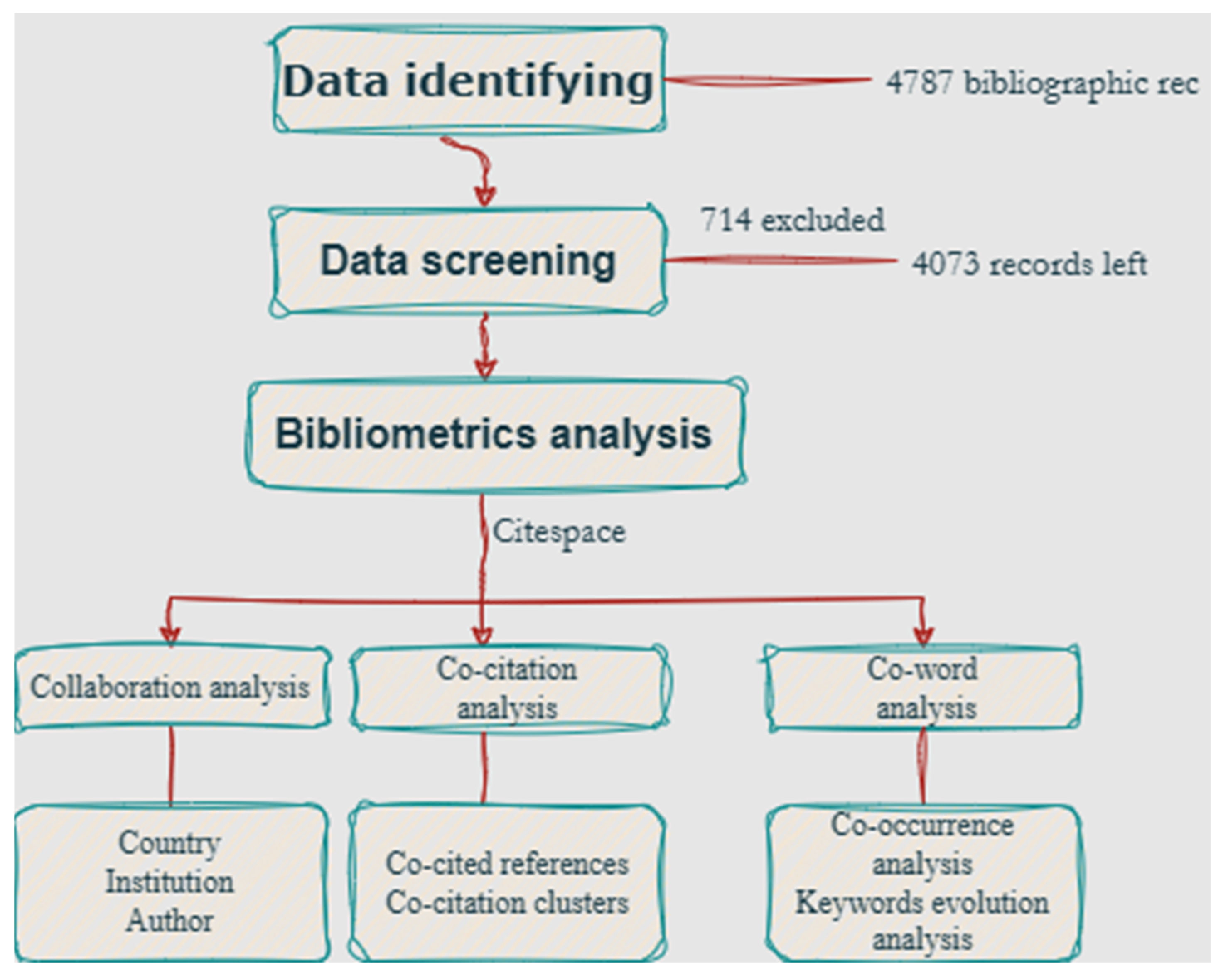
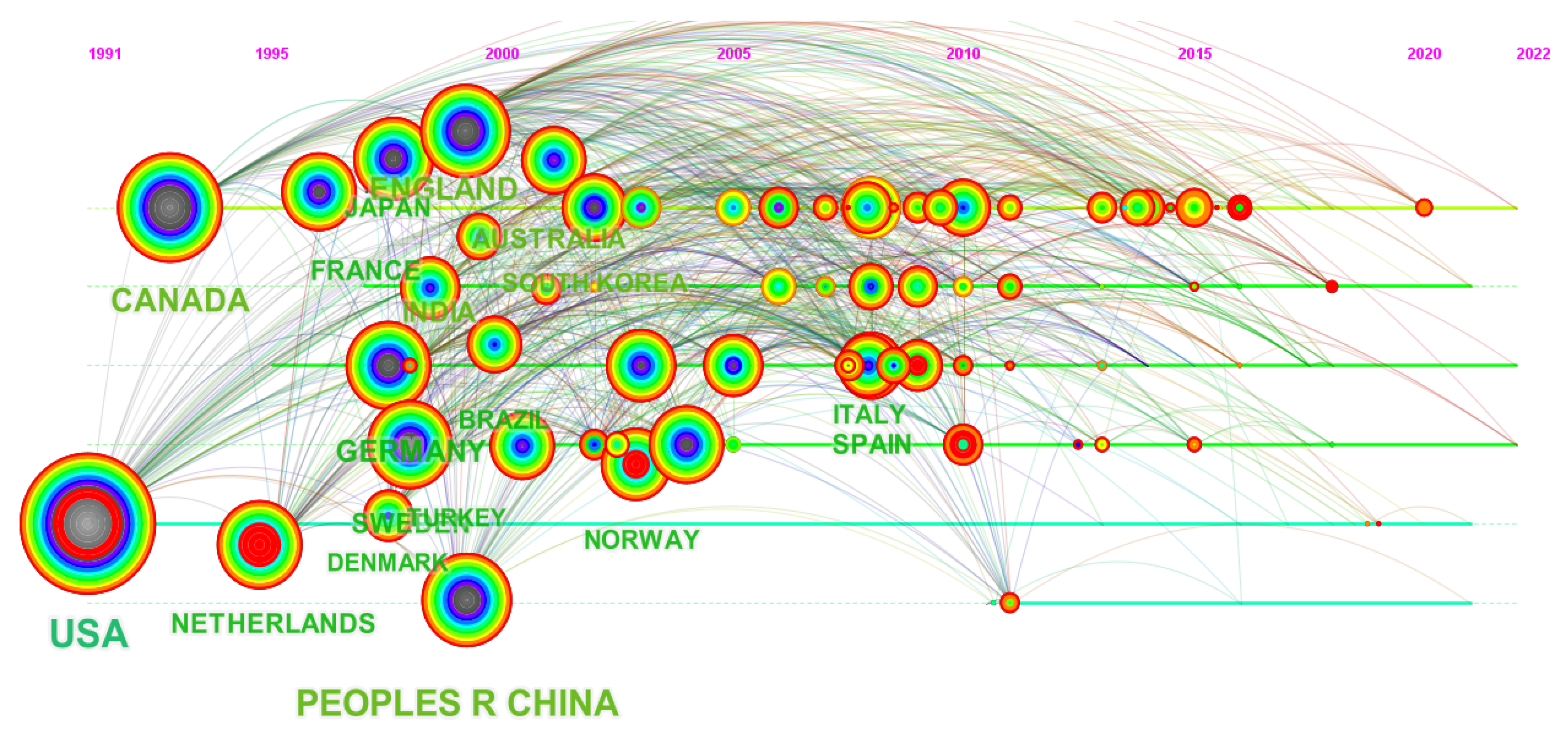
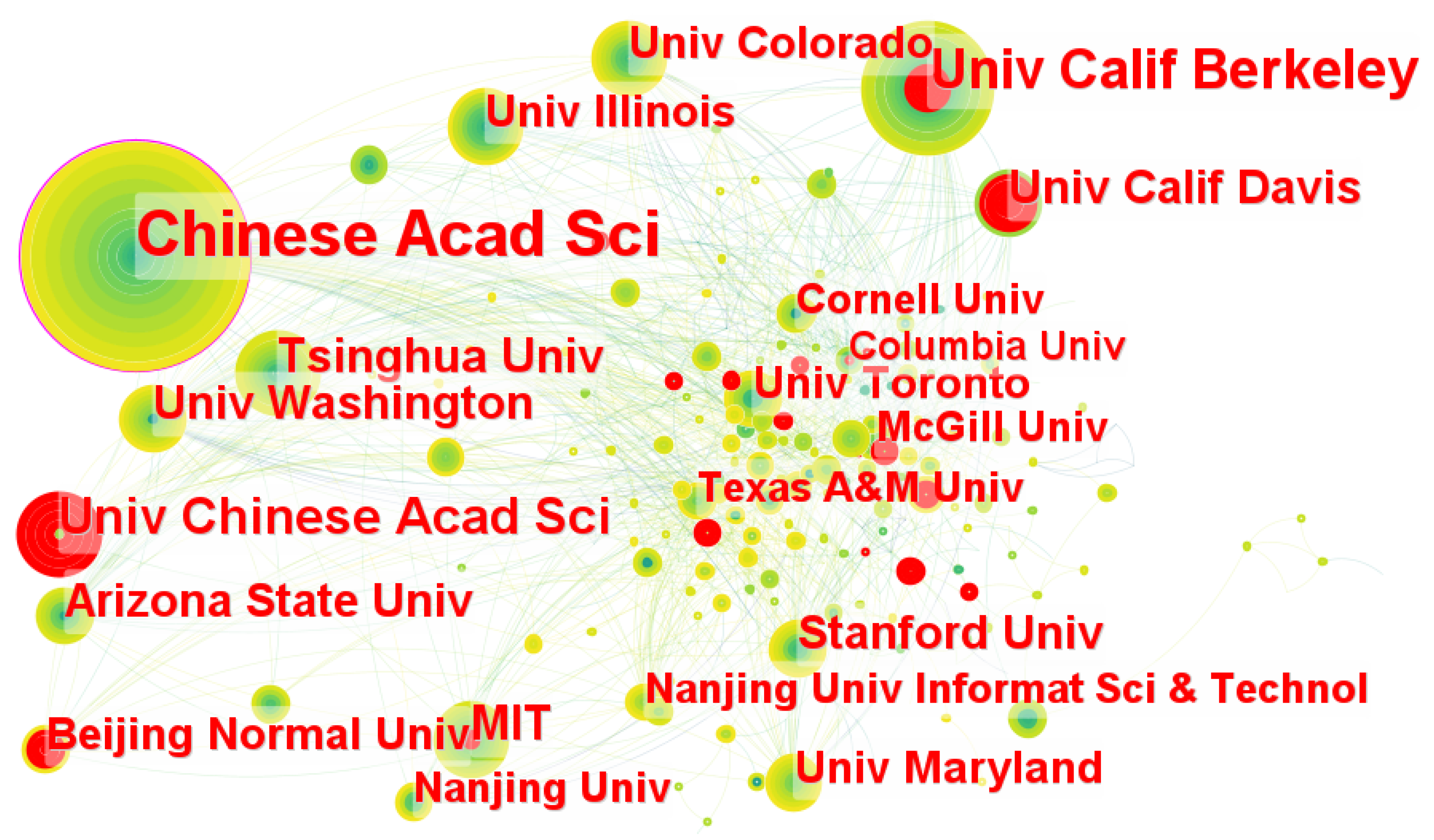
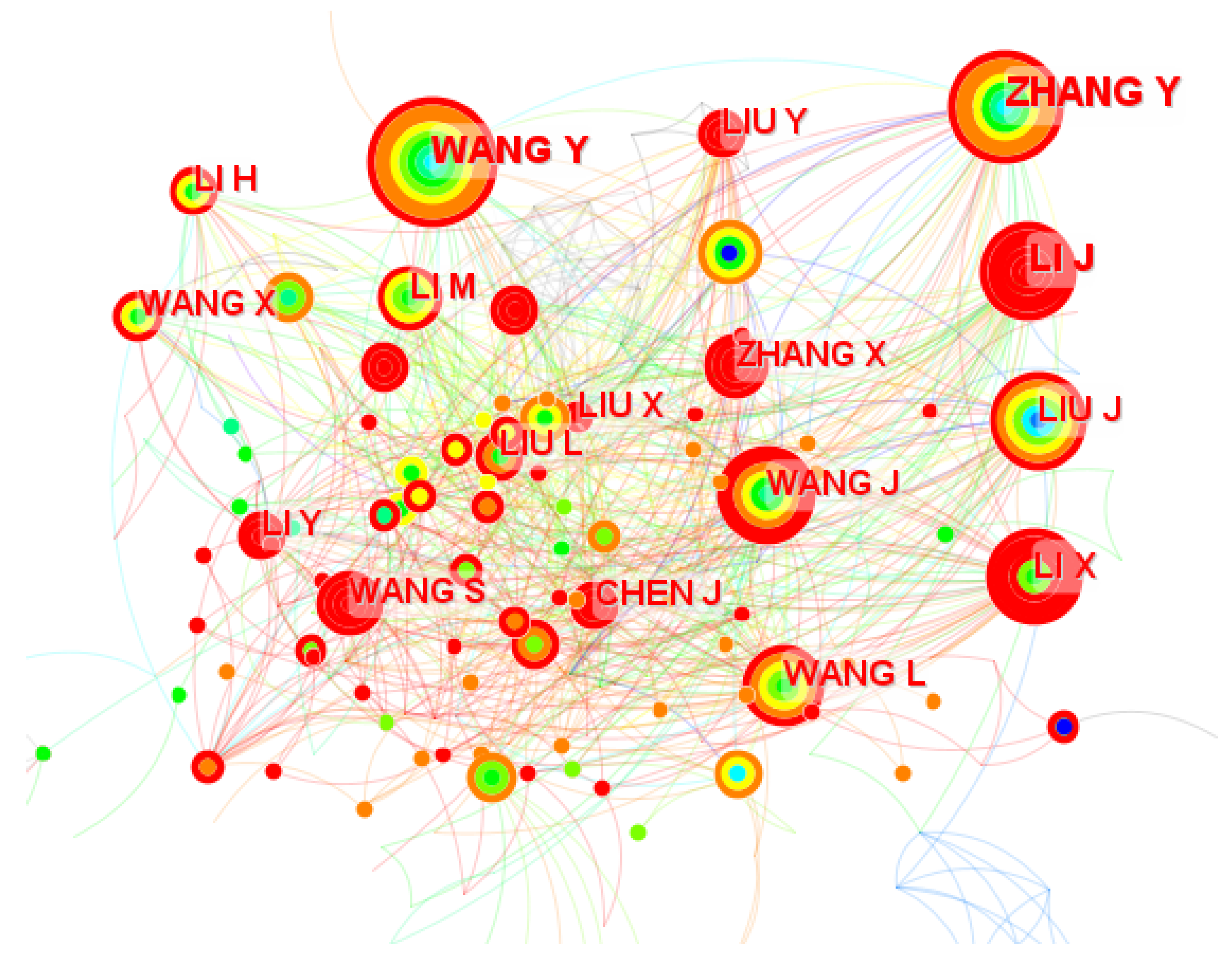
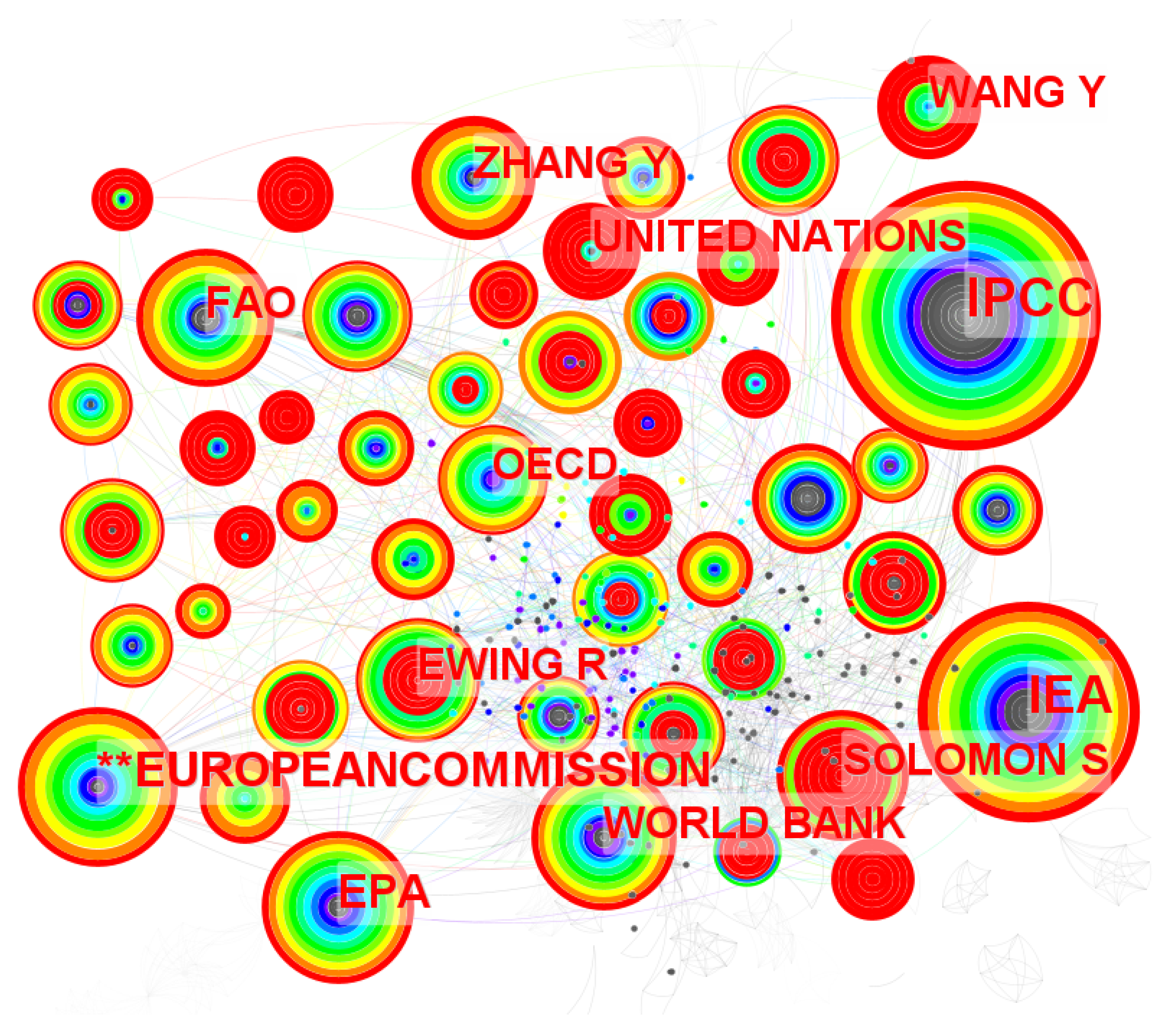
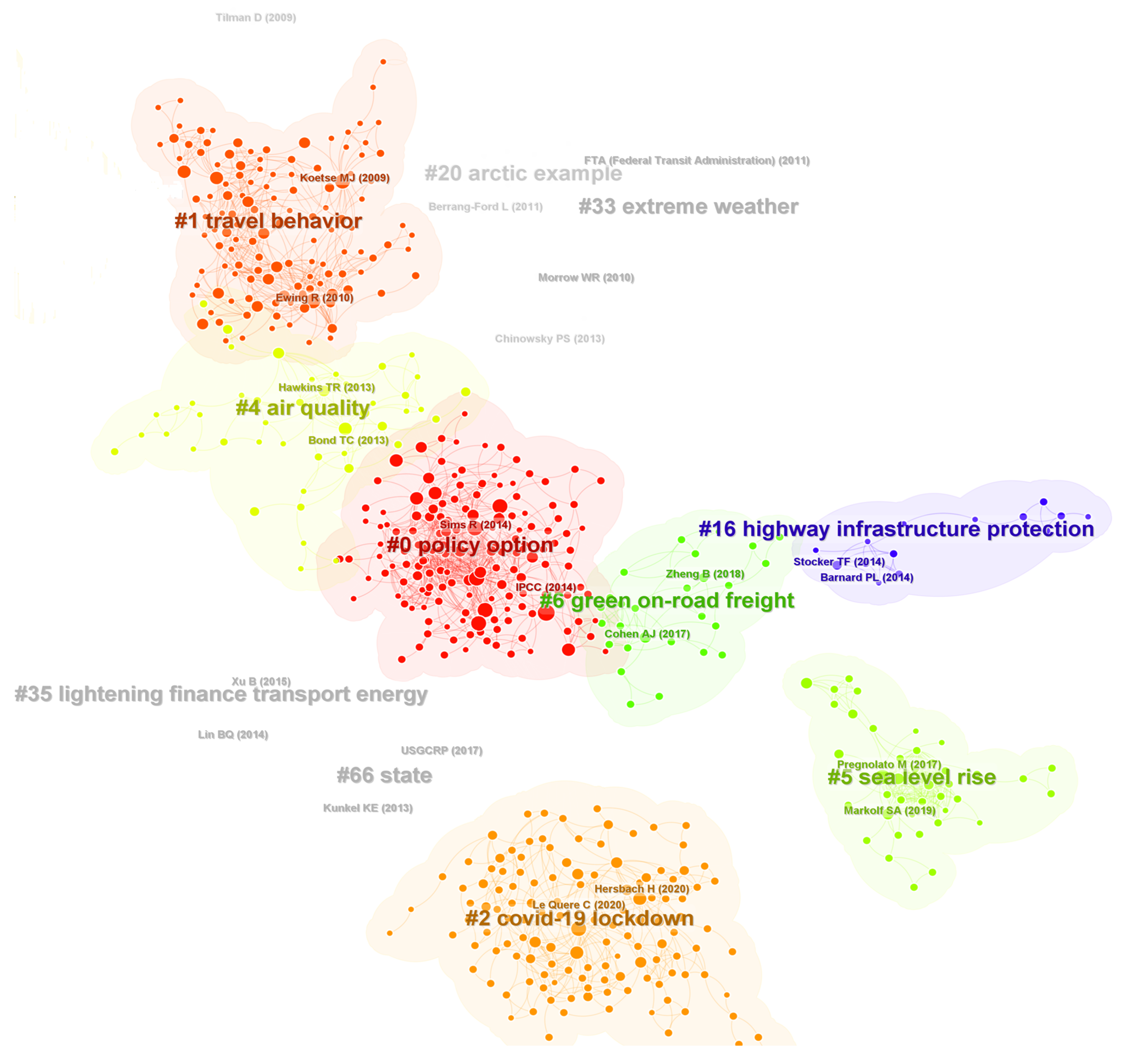
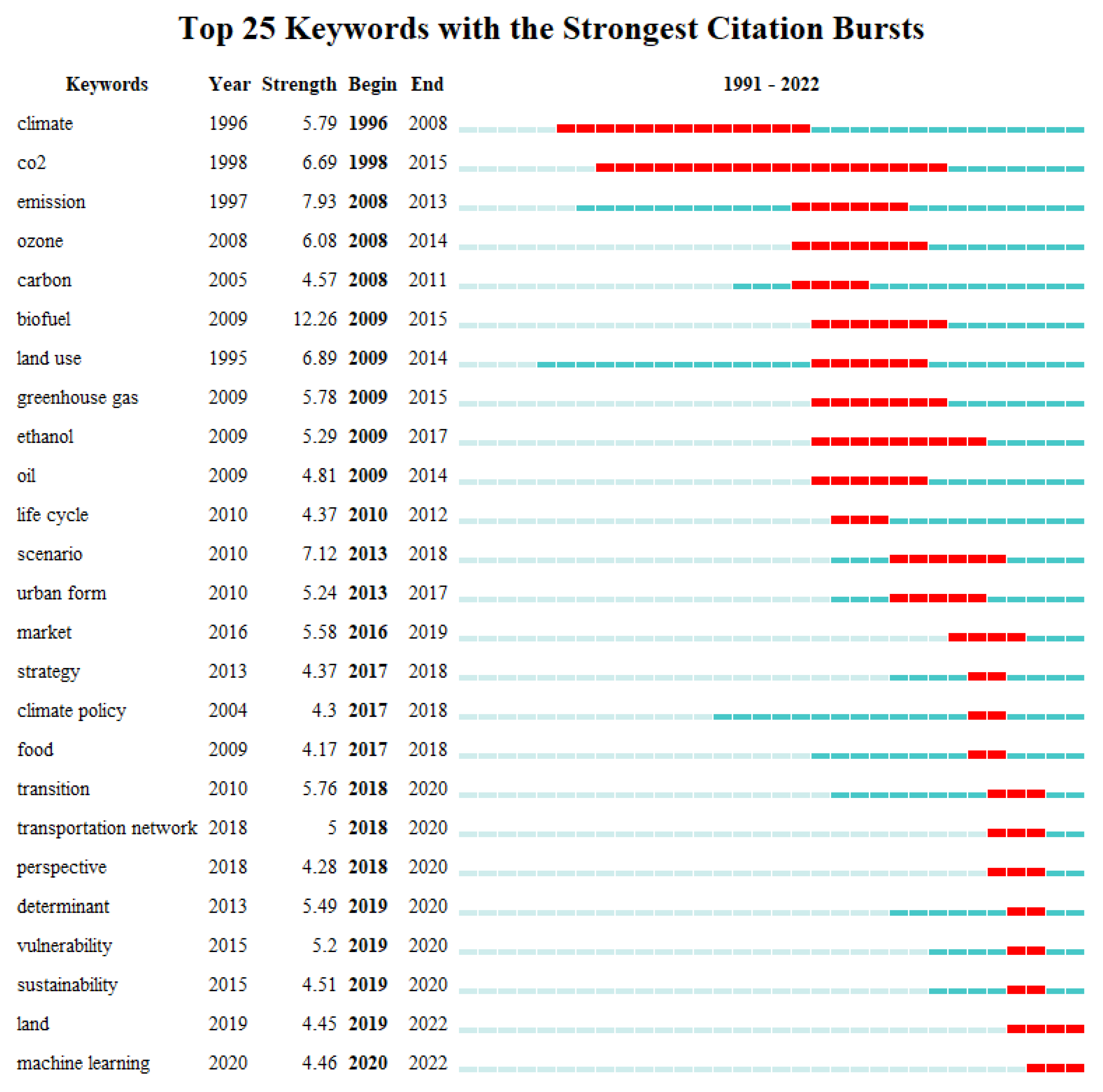
| Data Source | WoS |
|---|---|
| Search query | TS = (climate change) and TS = (transportation) |
| Retrieval time | 20 September 2022 |
| Time span | Unlimited |
| Quality measure | Peer-reviewed research papers in English |
| No of records | 4073 |
| Country | Publications | Centrality | Country | Publications | Centrality |
|---|---|---|---|---|---|
| US | 1368 | 0.39 | India | 162 | 0.01 |
| China | 721 | 0.07 | Australia | 140 | 0.08 |
| Canada | 345 | 0.11 | Sweden | 131 | 0.05 |
| United Kingdom | 294 | 0.12 | France | 128 | 0.13 |
| Germany | 211 | 0.19 | Spain | 122 | 0.08 |
| Institution | Publications | Centrality | Country/Region |
|---|---|---|---|
| University of Chinese Academy of Social Sciences | 161 | 0.19 | China |
| University of California, Berkeley | 75 | 0.05 | US |
| Tsinghua University | 41 | 0.04 | China |
| Massachusetts Institute of Technology | 40 | 0.01 | US |
| Arizona State University | 38 | 0.03 | US |
| University of Washington | 37 | 0.06 | US |
| Stanford University | 35 | 0.05 | US |
| University of California, Davis | 34 | 0.01 | US |
| University of Colorado Boulder | 31 | 0.03 | US |
| University Of Illinois | 31 | 0.01 | US |
| Author | Publications | Centrality | Author | Publications | Centrality |
|---|---|---|---|---|---|
| Zhang Yan | 35 | 0.02 | L. Wang | 24 | 0.01 |
| Y. Wang | 33 | 0.01 | J. Wang | 22 | 0.02 |
| J. Li | 31 | 0.01 | Y. Liu | 21 | 0.01 |
| J. Liu | 26 | 0.02 | X Zhang | 19 | 0.02 |
| X. Li | 26 | 0.02 | Y. Liu | 18 | 0.01 |
| Top 10 Authors/Organisations in Co-Citation Frequency | Top 10 Authors/Organisations in Burst Strength | Top 10 Authors/Organisations in Centrality |
|---|---|---|
| IPCC (378) | Farrell, Alexander E (21.19) | Stacy Davis (0.12) |
| IEA (248) | IEA (17.45) | IEA (0.09) |
| European Commission (160) | US EPA (17.33) | IPCC (0.07) |
| US EPA (130) | Timothy Searchinger (17.08) | Hao Wang (0.07) |
| World Bank (117) | Joseph Fargione (16.74) | James E. Hansen (0.06) |
| Yi Zhang (115) | US DOE (15.16) | Reid Ewing (0.06) |
| Susan Solomon (111) | IPCC (13.81) | Lee Chapman (0.05) |
| FAO (109) | Andreas Schafer (13.58) | European Commission (0.05) |
| United Nations (102) | Robert Socolow (13.26) | Wang, Zhichao (0.05) |
| Yue Wang (96) | David Pimentel (13.20) | FAO (0.05) |
| No. | Citation Counts | References | Source Journal/Publisher |
|---|---|---|---|
| 1 | 34 | Factoring greenhouse gas emissions from land use change into biofuel calculations [22] | Science |
| 2 | 31 | Climate change 2014 synthesis report [22] | IPCC |
| 3 | 30 | Land clearing and the biofuel carbon debt [23] | Science |
| 4 | 28 | Ethanol Can Contribute to Energy and Environmental Goals [24] | Science |
| 5 | 23 | Mitigation of climate change [25] | IPCC |
| 6 | 22 | Temporary reduction in daily global CO2 emissionsduring the COVID-19 forced confinement [26] | Nature climate change |
| 7 | 221 | Paris Agreement climate proposals needa boost to keep warming well below 2 °C [27] | Nature |
| 8 | 21 | Travel and the built environment: A meta-analysis [28] | Journal of the American planning association |
| 9 | 18 | Climate change 2013: the physical science basis: Working Group I contribution to the Fifth assessment report of the Intergovernmental Panel on Climate Change | Cambridge university press |
| 10 | 18 | Global warming of 1.5 °C [29] | IPCC |
| Cluster ID | Size | Silhouette | Mean (Year) | Top Terms (Log-Likelihood Ratio) |
|---|---|---|---|---|
| 0 | 159 | 0.93 | 2014 | Policy option |
| 1 | 129 | 0.871 | 2009 | Travel behaviour |
| 2 | 129 | 0.943 | 2018 | COVID-19 lockdown |
| 3 | 82 | 0.966 | 207 | Environmental cost |
| 4 | 45 | 0.942 | 2011 | Air quality |
| 5 | 29 | 0.983 | 2017 | Sea level rise |
| 6 | 28 | 0.99 | 2016 | Green on-road freight |
| 13 | 16 | 0.999 | 2001 | Oil dependence carbon emission |
| 16 | 14 | 0.997 | 2015 | Sea level |
| 20 | 12 | 0.995 | 2011 | Arctic example |
| 25 | 10 | 0.996 | 2008 | Marine resource |
| 33 | 9 | 1 | 2011 | Extreme weather |
| 35 | 8 | 0.996 | 2014 | Lightening finance Transport energy |
| 66 | 4 | 0.998 | 2014 | State |
| Top 10 Keywords in Co-Occurrence Frequency | Top 10 Keywords in Burst Strength | Top 10 Keywords in Centrality |
|---|---|---|
| Climate change (1310) | Biofuel (12.26) | Climate change (0.17) |
| Impact (530) | Emission (7.93) | Climate (0.13) |
| Emission (251) | Scenario (7.12) | Air pollution (0.08) |
| Energy (249) | Land use (6.89) | Bioma (0.07) |
| Model (244) | CO2 (6.69) | United states (0.06) |
| Life cycle assessment (242) | Ozone (6.08) | Evolution (0.06) |
| Greenhouse gas emission (229) | Climate (5.79) | Land use (0.05) |
| System (211) | Greenhouse gas emission (5.78) | CO2 (0.05) |
| Transportation (183) | Transition (5.76) | Carbon (0.05) |
| Cliamte (181) | Market (5.58) | Biofuel (0.05) |
Disclaimer/Publisher’s Note: The statements, opinions and data contained in all publications are solely those of the individual author(s) and contributor(s) and not of MDPI and/or the editor(s). MDPI and/or the editor(s) disclaim responsibility for any injury to people or property resulting from any ideas, methods, instructions or products referred to in the content. |
© 2023 by the authors. Licensee MDPI, Basel, Switzerland. This article is an open access article distributed under the terms and conditions of the Creative Commons Attribution (CC BY) license (https://creativecommons.org/licenses/by/4.0/).
Share and Cite
Peng, W.; Haron, N.A.; Alias, A.H.; Law, T.H. Knowledge Map of Climate Change and Transportation: A Bibliometric Analysis Based on CiteSpace. Atmosphere 2023, 14, 434. https://doi.org/10.3390/atmos14030434
Peng W, Haron NA, Alias AH, Law TH. Knowledge Map of Climate Change and Transportation: A Bibliometric Analysis Based on CiteSpace. Atmosphere. 2023; 14(3):434. https://doi.org/10.3390/atmos14030434
Chicago/Turabian StylePeng, Wang, Nuzul Azam Haron, Aidi Hizami Alias, and Teik Hua Law. 2023. "Knowledge Map of Climate Change and Transportation: A Bibliometric Analysis Based on CiteSpace" Atmosphere 14, no. 3: 434. https://doi.org/10.3390/atmos14030434
APA StylePeng, W., Haron, N. A., Alias, A. H., & Law, T. H. (2023). Knowledge Map of Climate Change and Transportation: A Bibliometric Analysis Based on CiteSpace. Atmosphere, 14(3), 434. https://doi.org/10.3390/atmos14030434






